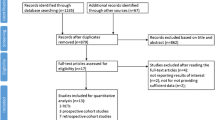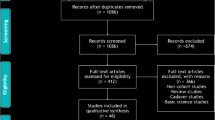Abstract
The Fixion™ system (Disc-O-Tech Medical Technologies, Herzeliya, Israel), which is currently the only expandable nailing system available for use in the humerus, has a number of purported advantages over the standard locked humeral nail, including a reduction in operating and fluoroscopy time since locking screws are not required. A systematic review was undertaken of all published (AMED, CINAHL, EMBASE and Medline via the Ovid platform) and unpublished or grey literature research databases from inception until 1st December 2010. Demographic data, clinical and radiological outcomes, and complications were extracted from each study by two independent investigators, and each study underwent independent critical appraisal using the CASP appraisal tool. Thirteen studies were deemed eligible for review, identified from a total of 154 citations. These included a total of 176 patients with 180 fractured humeri treated with expandable nails. Overall, 7.8% of humeral fractures treated with an expandable nail went on to non-union. Intra- and post-operative device failure rate was found to be 1.1 and 2.8%, respectively. These data compare favourably to published data on the outcome of locked humeral nails. However, there were numerous methodological flaws in the current evidence base; there were no comparative studies, treatment groups were heterogeneous, and there was no blinding of assessors or patients. Initial data indicate that the expandable humeral nail may be an acceptable form of treatment for humeral fracture or impending fracture, but high-quality comparative studies are needed to confirm these findings.




Similar content being viewed by others
References
Tytherleigh-Strong G, Walls N, McQueen MM (1998) The epidemiology of humeral shaft fractures. J Bone Joint Surg Br 80(2):249–253
Sarmiento A, Waddell JP, Latta LL (2002) Diaphyseal humeral fractures: treatment options. Instr Course Lect 51:257–269
Foulk DA, Szabo RM (1995) Diaphyseal humerus fractures: natural history and occurrence of nonunion. Orthopedics 18(4):333–335
Modabber MR, Jupiter JB (1998) Operative management of diaphyseal fractures of the humerus. Plate versus nail. Clin Orthop Relat Res 347:93–104
Lepore S, Capuano N, Lepore L, Romano G (2000) Preliminary clinical and radiographic results with the Fixion intramedullary nail: an inflatable self-locking system for long bone fractures. J Orthopaed Traumatol 3:135–140
Koval KJ, Clapper MF, Brumback RJ, Ellison PS, Poka A, Bathon GH, Burgess AR (1991) Complications of reamed intramedullary nailing of the tibia. J Orthop Trauma 5(2):184–189
Schemitsch EH, Kowalski MJ, Swiontkowski MF, Senft D (1994) Cortical bone blood flow in reamed and unreamed locked intramedullary nailing: a fractured tibia model in sheep. J Orthop Trauma 8(5):373–382
Curtis MJ, Brown PR, Dick JD, Jinnah RH (1995) Contaminated fractures of the tibia: a comparison of treatment modalities in an animal model. J Orthop Res 13(2):286–295
Mallick E, Hazarika S, Assad S, Scott M (2008) The Fixion® nailing system for stabilising diaphyseal fractures of the humerus: a two-year clinical experience. Acta Orthop Belg 74:308–316
Franck W, Olivieri M, Jannasch O, Hennig F (2002) An expandable nailing system for the management of pathological humerus fractures. Arch Orthop Trauma Surg 122:400–405
Lorich DG, Geller DS, Yacoubian SV, Leo AJ, Helfet DL (2003) Intramedullary fixation of humeral shaft fractures using an inflatable nail. Orthopedics 26(10):1011–1014
Jovanovic A, Pirpiris M, Semirli H, Doig SG (2004) Fixion (TM) nails for humeral fractures. Injury 35(11):1140–1142
Xiao-jian H, Zhi-quan A, Xiao-xing X, Chai-lai J (2009) Outcomes of expandable nailing system for humeral shaft fractures. J Clin Rehabil Tissue Eng Res 13:3347–3351
Capelli RM, Galmarini V, Molinari GP, De Amicis A (2003) The Fixion expansion nail in the surgical treatment of diaphyseal fractures of the humerus and tibia. Our experience. Chir Organi Mov 88(1):57–64
Daccarett M, Walz BM, Seligson D (2004) Use of an expandable nail in the treatment of non-union fractures of the femur, tibia and humerus. Osteosynth Trauma Care 12:130–134
Panidis G, Sayegh F, Beletsiotis A, Hatziemmanuil D, Antosidis K, Natsis K (2003) The use of an innovative inflatable self-locking intramedullary nail in treating and stabilizing long bone fractures. Technique-preliminary results. Osteosynth Trauma Care 11:108–112
Siegel HJ, Sessions W, Casillas MA (2008) Stabilization of pathologic long bone fractures with the Fixion expandable nail. Orthopedics 31(2):143
Ozturk H, Unsaldi T, Oztemur Z, Bulut O, Korkmaz M, Demirel H (2008) Extreme complications of Fixion nail in treatment of long bone fractures. Arch Orthop Trauma Surg 128:301–306
Galasso O, Mariconda M, Romano G, Capuano N, Romano L, Ianno B, Milano C (2008) Expandable intramedullary nailing and platelet rich plasma to treat long bone non-unions. J Orthop Traumatol 9(3):129–134
Daglar B, Bayrakci K, Tasbas BA, Gurkan I, Agar M, Gunel U (2002) Short-term results of treatment of humeral and tibial fractures with new inflatable intramedullary nails. Acta Orthop Traumatol Turc 36:322–327
Constant CR, Murley AH (1987) A clinical method of functional assessment of the shoulder. Clin Orthop Relat Res 214:160–164
Lin J, Shen PW, Hou SM (2003) Complications of locked nailing in humeral shaft fractures. J Trauma 54(5):943–949
Lin J (1998) Treatment of humeral shaft fractures with humeral locked nail and comparison with plate fixation. J Trauma 44(5):859–864
McCormack RG, Brien D, Buckley RE, McKee MD, Powell J, Schemitsch EH (2000) Fixation of fractures of the shaft of the humerus by dynamic compression plate or intramedullary nail. A prospective, randomised trial. J Bone Joint Surg Br 82(3):336–339
Rommens PM, Kuechle R, Bord T, Lewens T, Engelmann R, Blum J (2008) Humeral nailing revisited. Injury 39(12):1319–1328
Chapman JR, Henley MB, Agel J, Benca PJ (2000) Randomized prospective study of humeral shaft fracture fixation: intramedullary nails versus plates. J Orthop Trauma 14(3):162–166
Zoccali C, Di Francesco A, Ranalletta A, Flamini S (2008) Clinical and radiological midterm results from using the Fixion expandable intramedullary nail in transverse and short oblique fractures of femur and tibia. J Orthop Traumatol 9(3):123–128
Steinberg EL, Geller DS, Yacoubian SV, Shasha N, Dekel S, Lorich DG (2006) Intramedullary fixation of tibial shaft fractures using an expandable nail: early results of 54 acute tibial shaft fractures. J Orthop Trauma 20(5):303–309
Smith WR, Ziran B, Agudelo JF, Morgan SJ, Lahti Z, Vanderheiden T, Williams A (2006) Expandable intramedullary nailing for tibial and femoral fractures: a preliminary analysis of perioperative complications. J OrthopTrauma 20(5):310–314
Phillips AW, Patel AD, Donell ST (2006) Explosion of Fixion® humeral nail during cremation: novel “complication” with a novel implant. Injury Extra 37:357–358
Conflict of interest
None declared. No funds were received in support of this study.
Author information
Authors and Affiliations
Corresponding author
Rights and permissions
About this article
Cite this article
Rose, D.M., Smith, T.O., Nielsen, D. et al. Expandable intramedullary nails for humeral fractures: a systematic review of clinical and radiological outcomes. Eur J Orthop Surg Traumatol 23, 1–11 (2013). https://doi.org/10.1007/s00590-011-0908-5
Received:
Accepted:
Published:
Issue Date:
DOI: https://doi.org/10.1007/s00590-011-0908-5




